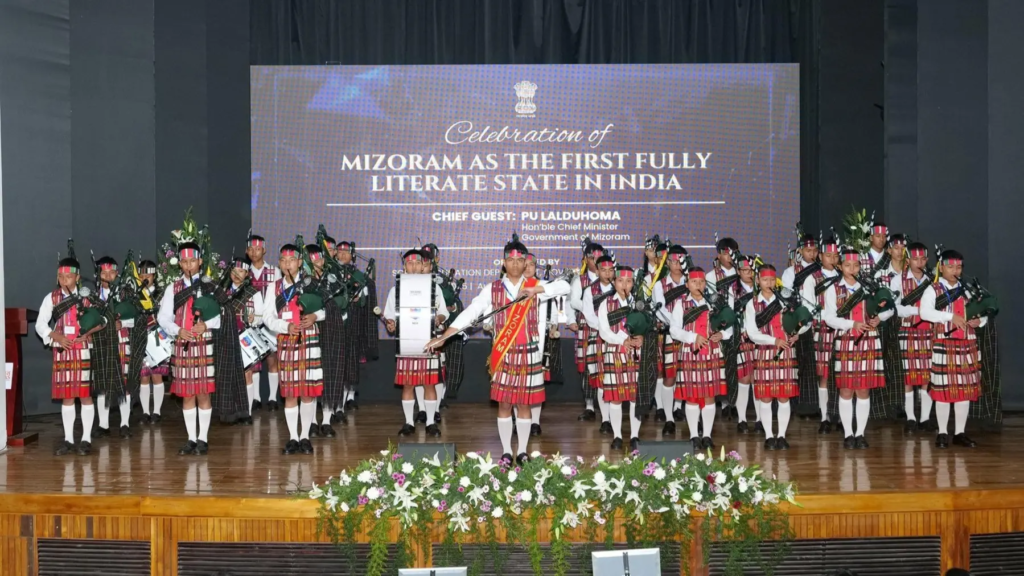MIZORAM has made history by becoming the first fully literate state in India, with a reported literacy rate of 98.2%, officially declared on May 20, 2025. This landmark achievement was announced during a formal event held at Mizoram University in Aizawl, where key dignitaries including Chief Minister Lalduhoma and Union Minister of State for Education Jayant Chaudhary were present.
This significant milestone marks the culmination of sustained efforts by the state government, civil society, educational institutions, and the local community to eradicate illiteracy and promote lifelong learning. Mizoram’s journey towards full literacy is being hailed as a model for other Indian states to emulate.
How did Mizoram achieve this historic milestone?
Mizoram’s success in attaining full literacy did not happen overnight. The state launched a focused literacy drive through the Understanding of Lifelong Learning for All in Society (ULLAS) program, aligned with the New India Literacy Programme (NILP) initiated by the central government. The program aimed to identify and educate the remaining illiterate population in the state.
During the campaign, authorities identified approximately 3,026 individuals who had not acquired basic reading and writing skills. Of these, 1,692 enrolled as learners and began literacy classes. The program was supported by a dedicated network of 292 volunteer teachers, drawn from students, educators, and resource persons within the community.
Community participation played a crucial role in Mizoram’s literacy push. The involvement of local organizations such as churches, the Young Mizo Association, and women’s self-help groups was vital in mobilizing support and creating awareness about the importance of education. The culturally ingrained value of Tlawmngaihna—which emphasizes altruism and selflessness—motivated many volunteers to contribute their time and effort to the cause.
Schools in Mizoram also emphasize instruction in the Mizo language, making education accessible and relatable to children from an early age. This approach contributed to low dropout rates and high school enrollment, building a strong foundation for literacy.
MIZORAM: What factors contributed to Mizoram’s success in achieving full literacy?
Several factors stand out in explaining Mizoram’s success:
- Community involvement: The strong presence of local social organizations and community groups fostered a supportive environment for literacy programs. Their active role in spreading awareness and facilitating adult education was instrumental.
- Government commitment: Mizoram’s government prioritized education funding and effective program implementation, ensuring that resources were directed to where they were needed most.
- Cultural ethos: The Mizo value of Tlawmngaihna encouraged selfless service towards community upliftment, which greatly helped mobilize volunteers and sustain efforts over time.
- Inclusive education policy: Teaching children in their mother tongue from the start helped maintain interest and understanding, thereby reducing dropout rates and ensuring a more literate younger generation.
- Focus on lifelong learning: Beyond basic literacy, Mizoram emphasized continuous education through adult literacy and skill development initiatives, ensuring even older populations had access to learning opportunities.

MIZORAM: How can other states replicate Mizoram’s literacy success?
With Mizoram’s success now setting a benchmark, many are asking how other Indian states can learn from this experience. The key takeaway is the importance of community-driven approaches supported by strong government backing. The involvement of local groups creates a sense of ownership and motivation among residents, which is crucial for sustaining literacy efforts.
Moreover, adopting mother tongue-based instruction in early education helps children connect better with their studies. Combining this with targeted adult literacy campaigns ensures no one is left behind.
States need to focus on inclusive policies that promote not only reading and writing but also digital and financial literacy to meet modern-day demands. Mizoram’s next step involves enhancing these areas, aiming for holistic education that prepares citizens for a rapidly changing world.
What does this milestone mean for Mizoram and India?
Mizoram’s declaration as India’s first fully literate state is a powerful symbol of progress and social development. It validates years of effort by the state’s government, educational institutions, volunteers, and citizens.
For India, this achievement offers a roadmap for tackling illiteracy across its diverse states and regions. It shows that even in difficult terrains and among smaller populations, comprehensive strategies can bring about transformative results.
Education experts say Mizoram’s success is a reminder that literacy is not just about numbers; it’s about empowering individuals, improving livelihoods, and building stronger communities.
Looking ahead: The future of literacy in Mizoram
Mizoram now aims to move beyond basic literacy to develop advanced skills among its population. Efforts are underway to enhance digital literacy, financial skills, and entrepreneurial training. These initiatives are expected to equip citizens better for employment opportunities and socio-economic growth.
The state government also plans to replicate the success of literacy programs in remote and tribal areas to maintain consistent educational standards everywhere.
Its achievements have attracted national attention and serve as an inspiring example of how cultural values combined with effective policy and community involvement can yield remarkable results.
ALSO READ
MBSE HSLC Result 2025: 76.68% Pass, Lalthakimi Tops Mizoram
School Enrollment Decline Over Two Years, Elementary Level Drops by 8%: Government